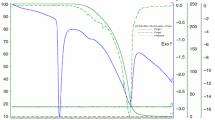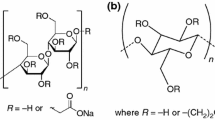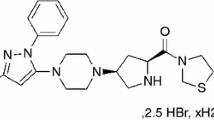Abstract
This paper deals with the study of excipient–excipient interactions, rather than more commonly studied drug–excipient interactions. It presents the compatibility study between two polymeric compounds used in pharmaceutical technology, namely polyvinyl alcohol and polyvinylpyrrolidone, with other commonly used pharmaceutical excipients, like starch, mannitol, sorbitol, magnesium stearate and hydroxyethyl cellulose. The compatibility investigations were carried out under ambient temperature by FTIR spectroscopy studies and later completed by the use of thermal analysis (TG/DTG/HF) data to study the influence of temperature over stability of binary mixtures.









Similar content being viewed by others
References
Hansen K, Kim G, Desai KGH, Patel H, Olsen KF, Curtis-Fisk J, Tocce E, Jordan S, Schwendeman SP. Feasibility investigation of cellulose polymers for mucoadhesive nasal drug delivery applications. Mol Pharmaceut. 2015;12(8):2732–41.
Fernandez-Ronco MP, Salvalaglio M, Kluge J, Mazzotti M. Study of the preparation of amorphous itraconazole formulations. Cryst Growth Des. 2015;15(6):2686–94.
Gift AD, Southard LA, Riesberg AL. Influence of polymeric excipient properties on crystal hydrate formation kinetics of caffeine in aqueous slurries. J Pharm Sci. 2012;101(5):1755–62.
Paduszyński P, Krusiński T, Han T, Musiał W. Early stage of drug release non-classified in BCS influenced by coating excipients: hydroxypropyl methylcellulose and polyvinyl alcohol. Lat Am J Pharm. 2016;35(1):84–90.
Puri V, Dantuluri AK, Bansal AK. Barrier coated drug layered particles for enhanced performance of amorphous solid dispersion dosage form. J Pharm Sci. 2012;101(1):342–53.
Diluccio RC, Hussain MA, Coffinbeach D, Torosian G, Shefter E, Hurwitz AR. Sustained-release oral delivery of theophylline by use of polyvinyl-alcohol and polyvinyl alcohol-methyl acrylate polymers. J Pharm Sci. 1994;83(1):104–6.
Gutch PK, Jitendra S, Alankar S, Anurekha J, Ganesan K. Thermal analysis of interaction between 2-PAM chloride and various excipients in some binary mixtures by TGA and DSC. J Therm Anal Calorim. 2011;111(3):1953–8.
Patel AR, Vavia PR. Evaluation of synthesized cross linked polyvinyl alcohol as potential disintegrant. J Pharm Pharm Sci. 2010;13(2):114–27.
Sinko PJ, Singh Y. Physical chemical and biopharmaceutical principles in the pharmaceutical sciences, 6th Edn. Pharmaceutical polymers. 2009. p. 492.
Fundueanu G, Constantin M, Bortolotti F, Cortesi R, Ascenzi P, Menegatti E. Cellulose acetate butyrate-pH/thermosensitive polymer microcapsules containing aminated poly(vinyl alcohol) microspheres for oral administration of DNA. Eur J Pharm Biopharm. 2007;66(1):11–20.
Heuschmid FF, Schneider S, Schuster P, Lauer B, van Ravenzwaay B. Polyethylene glycol-g-polyvinyl alcohol grafted copolymer: reproductive toxicity study in Wistar rats. Food Chem Toxicol. 2013;51:S24–35.
Prudic A, Ji YH, Luebbert C, Sadowski G. Influence of humidity on the phase behavior of API/polymer formulations. Eur J Pharm Biopharm. 2015;94:352–62.
Paus R, Prudic A, Ji YH. Influence of excipients on solubility and dissolution of pharmaceuticals. Int J Pharm. 2015;485(1–2):277–87.
Veronez IP, Daniel JSP, Junior CEC, Garcia JS, Trevisan MG. Development, characterization, and stability studies of ethinyl estradiol solid dispersion. J Therm Anal Calorim. 2015;120(1):573–81.
Halake K, Birajdar M, Kim BS, Bae H, Lee CC, Kim YJ, Kim S, Kim HJ, Ahn S, An Y. Recent application developments of water-soluble synthetic polymers. J Ind Eng Chem. 2014;20:3913–8.
Rasekh M, Karavasili C, Soong YL, Bouropoulos N, Morris M, Armitage D, Li X, Fatouros DG, Ahmad Z. Electrospun PVP-indomethacin constituents for transdermal dressings and drug delivery devices. Int J Pharm. 2014;473(1–2):95–104.
Ledeti I, Vlase G, Vlase T, Ciucanu I, Olariu T, Todea A, Fulias A, Suta LM. Instrumental analysis of potential lovastatin–excipient interactions in preformulation studies. Rev Chim (Bucharest). 2015;66(6):879–82.
Ledeti I, Vlase G, Ciucanu I, Olariu T, Fulias A, Suta LM, Belu I. Analysis of solid binary systems containing simvastatin. Rev Chim (Bucharest). 2015;66(2):240–3.
Ledeti I, Vlase G, Vlase T, Suta LM, Todea A, Fulias A. Selection of solid-state excipients for simvastatin dosage forms through thermal and nonthermal techniques. J Therm Anal Calorim. 2015;121(3):1093–102.
de Melo CM, Vieira ACQD, do Nascimento ALD, Figueiredo CBM, Rolim LA, Soares-Sobrinho JL, Veras LMC, Leite JRDD, Neto PJR, Soares MFD. A compatibility study of the prototype epiisopiloturine and pharmaceutical excipients aiming at the attainment of solid pharmaceutical forms. J Therm Anal Calorim. 2015;120(1):689–97.
Vieira ACQD, Marques GS, de Melo CM, da Silva KER, Rolim LA, de Lima MDA, Galdino SL, Pitta ID, Neto PJR. Physical-chemical characterization of new anti-inflammatory agent (LPSF/GQ-130) and evaluation of its thermal compatibility with pharmaceutical excipients. J Therm Anal Calorim. 2014;115(3):2339–49.
Chaves LL, Rolim LA, Goncalves MLCM, Vieira ACC, Alves LDS, Soares MFR, Soares-Sobrinho JL, Lima MCA, Rolim-Neto PJ. Study of stability and drug–excipient compatibility of diethylcarbamazine citrate. J Therm Anal Calorim. 2013;111(3):2179–86.
Bruni G, Berbenni V, Milanese C, Girella A, Marini A. Drug–excipient compatibility studies in binary and ternary mixtures by physico-chemical techniques. J Therm Anal Calorim. 2010;102(1):193–201.
Acknowledgements
Roxana Blajovan (Ph.D. student) was cofinanced in this work from the European Social Fund through Sectoral Operational Programme Human Resources Development 2007–2013, Project Number POSDRU/187/1.5/S/155559, Competitive Multidisciplinary Doctoral Research in Europe.
Author information
Authors and Affiliations
Corresponding author
Rights and permissions
About this article
Cite this article
Blajovan, R., Ledeţi, I., Vlase, G. et al. Study of thermal induced excipient–excipient interactions. J Therm Anal Calorim 126, 171–179 (2016). https://doi.org/10.1007/s10973-016-5348-3
Received:
Accepted:
Published:
Issue Date:
DOI: https://doi.org/10.1007/s10973-016-5348-3




